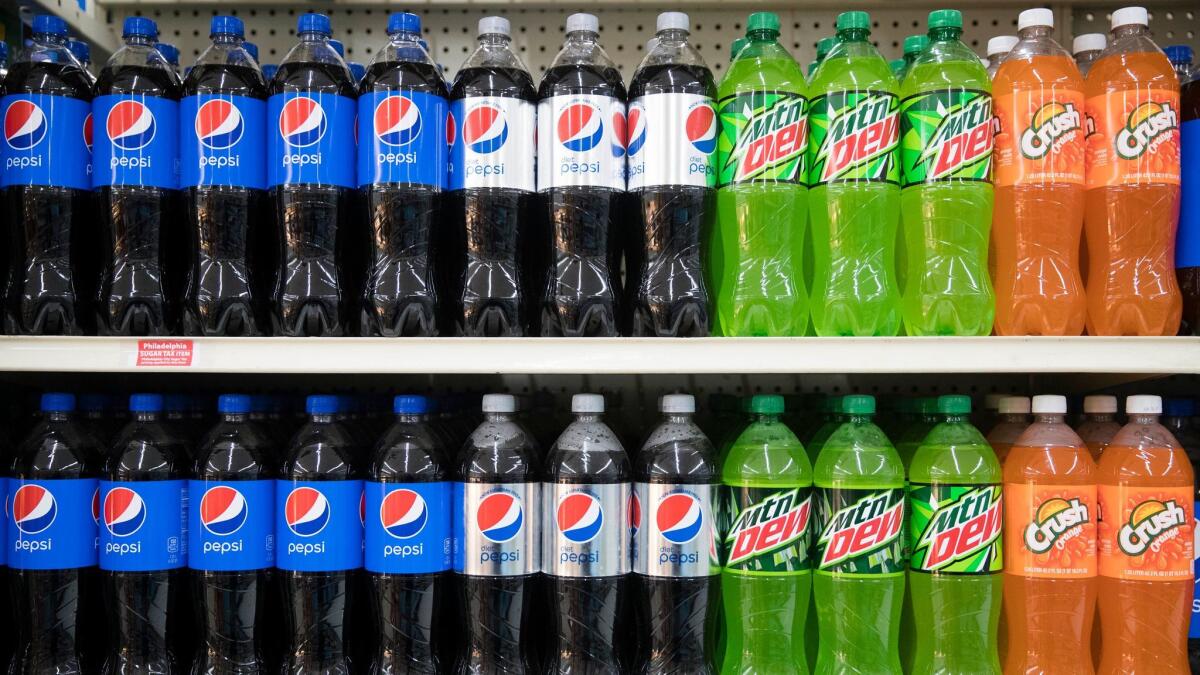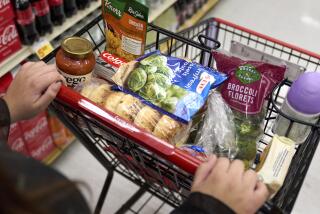Editorial: Are we subsidizing a public health crisis by allowing the poor to buy soda with food stamps?

- Share via
A major study of the grocery-buying habits of millions of Americans released late last year found that people using food stamps generally make the same unhealthy food choices as everyone else in America. Too many sweets, salty snacks and prepared desserts. Junk food, in other words.
But when it came to soda and its sugary ilk, the results were more surprising, and not in a good way. According to the USDA-funded study, shoppers using food stamps spent a larger share of their budget — 9.25% to be exact — on sugar-sweetened beverages than other shoppers. Even more startling: Food-stamp shoppers bought more soda than any other single grocery item.
The new data revived an old debate about banning soda from the $71-billion food-stamp program. In February, the House Agriculture Committee held a hearing to gather testimony about the pros and cons of such a restriction. It does seem counterproductive to spend billions of taxpayer dollars in an effort to improve the nutrition of low-income Americans on a product with little or no nutritional value. It is called the Supplemental Nutrition Assistance Program, after all. What’s worse is that soda has been identified by public health experts as one of the prime culprits in soaring U.S. obesity and Type 2 diabetes rates.
Food-stamp shoppers bought more soda than any other single grocery item.
The study and committee debate, however, raised some of the same uncomfortable issues that have caused the proposal to languish in the past. On the conservative side, folks have worried that this type of nanny-state regulation will lead to other heavy-handed health-related restrictions (enforced exercise, perhaps). Liberals, meanwhile, have been concerned that it is patronizing and punitive to tell people how to spend their government benefits. Add in the opposition from beverage industry lobby and it’s no surprise this idea hasn’t gotten very far when it’s been proposed in the past. In recent years, a handful of states and cities, including New York City, have tried to impose such a requirement, but were blocked by the U.S. Department of Agriculture.
The difference now is that the attitude toward soda has rapidly soured as more evidence has poured in that beverages with added sugars are making people fat and sick. The USDA has issued dietary guidelines warning people to limit their consumption of food with added sugars, the largest sources of which are sweetened beverages. This belief helped San Francisco, Philadelphia and handful of other cities push through new taxes on soda. A handful more are considering their own soda levies, and it wouldn’t be a surprise to see an effort to adopt a statewide soda tax in California before too long.
We know that there are detrimental health effects of drinking lots of soda, but we don’t know if barring SNAP recipients from spending their benefits on soda will really improve their health. It’s worth finding out by undertaking a limited pilot program, regardless of the qualms we may have about imposing restraints on the poor that better-off Americans don’t face. The assumption is that those billions of dollars not going to buy Coke or Red Bull will be spent on healthier food. But that may not be the case. What if consumption of other sugary items, like ice cream and pudding, increases? Or if SNAP recipients simply transferred their sweet drink habit ounce-for-ounce to more expensive and still sugar-laden fruit juice? Or if they spent their non-SNAP money on soda? Before making a permanent change, we need to know if it would improve nutrition or be pointlessly punitive.
But it is a good step to take to gather data. And the argument that it would be too hard on grocers to carve out sugary drinks doesn’t hold water. As the study shows, modern grocery check stand technology is sophisticated enough to easily separate out purchases by UPC code. Indeed, SNAP already comes with restrictions on alcohol, tobacco and hot foods, among other things. Grocers don’t have a problem sorting them out. The Women, Infant and Children food-assistance program is even more prescriptive, permitting only specific items to be purchased: milk, cheese, cereal and formula, for example, but absolutely nothing with added sugar or artificial sweetener. Ideally, a pilot program would also find ways to improve access to safe drinking water. One of the reasons that low-income people may choose sweetened beverages is that their drinking water isn’t reliable.
Denying poor people the ability to use food aid to buy a Coke on a hot day may raise some unsettling questions. Yet the findings in the USDA’s study about excessive soda consumption shouldn’t be ignored.
Follow the Opinion section on Twitter @latimesopinion and Facebook
More to Read
A cure for the common opinion
Get thought-provoking perspectives with our weekly newsletter.
You may occasionally receive promotional content from the Los Angeles Times.









